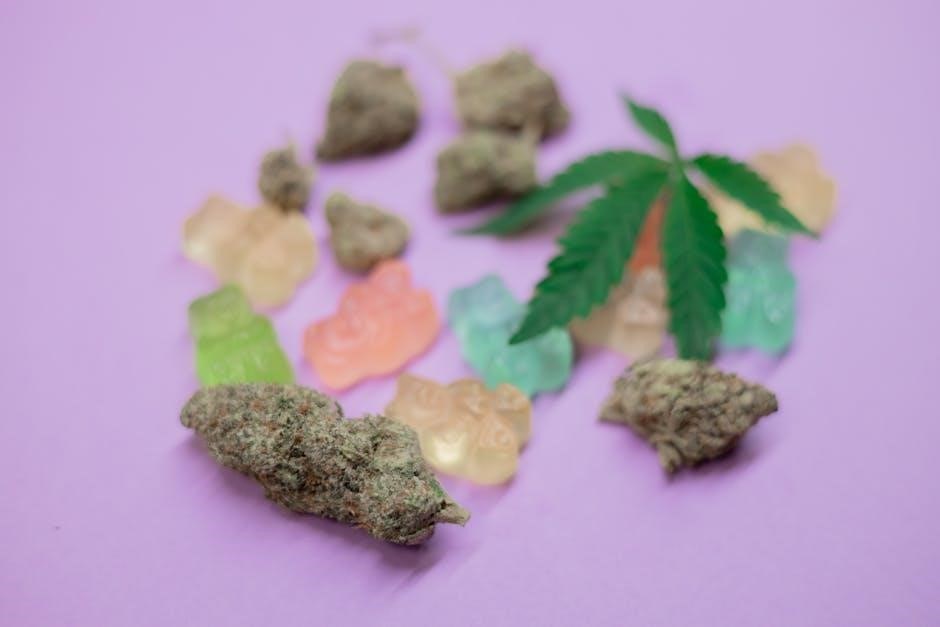Marijuana edibles are cannabis-infused foods or drinks that offer a discreet and flavorful way to consume THC. Unlike smoking‚ edibles provide a longer-lasting‚ smoother high‚ appealing to health-conscious users and those seeking therapeutic benefits. This guide explores their benefits‚ dosage‚ and safe preparation methods.
Benefits of Edibles Over Smoking
Marijuana edibles offer several advantages over smoking‚ making them a preferred choice for many consumers. Unlike smoking‚ edibles provide a longer-lasting and smoother high‚ as THC is metabolized through the digestive system rather than the lungs. This method eliminates the harmful effects of combustion‚ such as tar and carcinogens‚ making it a healthier alternative for respiratory health. Edibles also allow for precise dosing‚ reducing the risk of overconsumption and providing a more controlled experience. Additionally‚ edibles are discreet and odorless‚ making them ideal for those who prefer privacy. They also come in a variety of flavors and forms‚ catering to diverse preferences. Many users report that edibles produce stronger and more intense effects compared to smoking‚ which can be beneficial for therapeutic purposes. Furthermore‚ edibles are often preferred by individuals who want to avoid the harshness of smoke or are looking for a more comfortable way to consume cannabis. Overall‚ edibles provide a convenient‚ potent‚ and enjoyable alternative to traditional smoking methods.
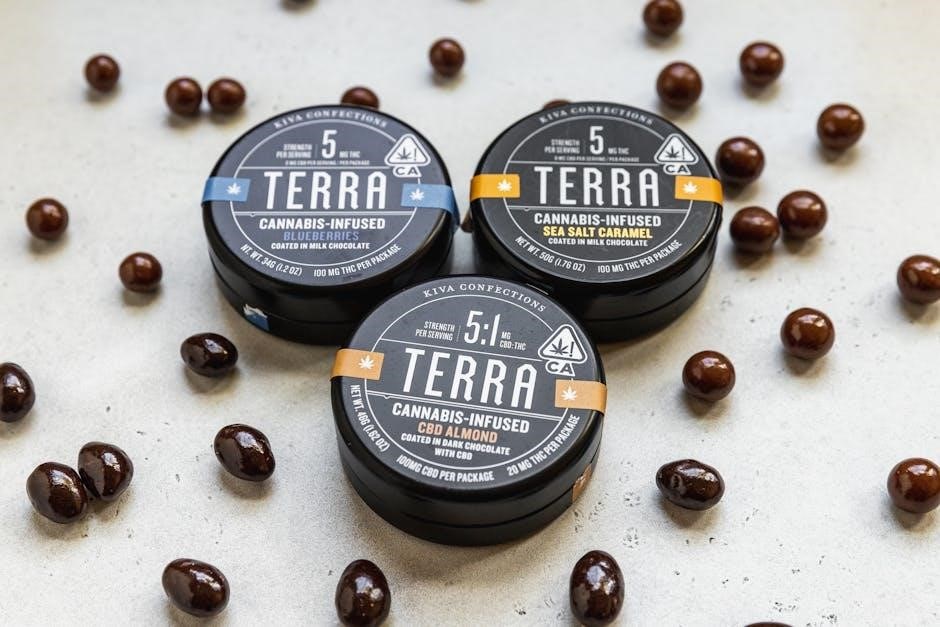
Understanding Dosage and Potency
Dosage and potency are crucial for safe and enjoyable edible experiences. Start with low doses (5-10mg THC) to gauge tolerance. Potency varies based on cannabis quality‚ infusion methods‚ and individual metabolism. Accurate measurement ensures consistent effects and avoids overwhelming experiences.
Calculating THC Content in Edibles
Calculating THC content in edibles involves understanding the potency of your cannabis and the amount used. Start by determining the THC percentage of your cannabis. For example‚ if you use 1 gram of cannabis with 20% THC‚ you have 200mg of THC. Divide this by the number of servings your recipe yields to find the THC per serving. For accuracy‚ use a precise scale and consider the efficiency of infusion methods‚ as some THC may be lost during cooking. Always label your edibles with their THC content to ensure safe and responsible consumption.
Managing Potency for Safe Consumption
Managing potency is crucial for a safe and enjoyable experience with marijuana edibles. Start with low doses to assess tolerance‚ as edibles can have potent and long-lasting effects. A general rule is to begin with 5-10mg of THC per serving and wait at least 60-90 minutes to gauge the effects before consuming more. Use labels to track THC content and portion sizes‚ ensuring clarity for yourself and others. Store edibles securely to prevent accidental ingestion by children or pets. Avoid mixing edibles with alcohol or other substances‚ as this can intensify side effects. Consider individual tolerance and metabolism‚ as these factors influence how THC is processed. For novice consumers‚ consider microdosing (1-2.5mg THC) to minimize risks. Always prioritize moderation and patience‚ as overconsumption can lead to discomfort or anxiety. By adhering to these guidelines‚ you can enjoy edibles responsibly and safely.
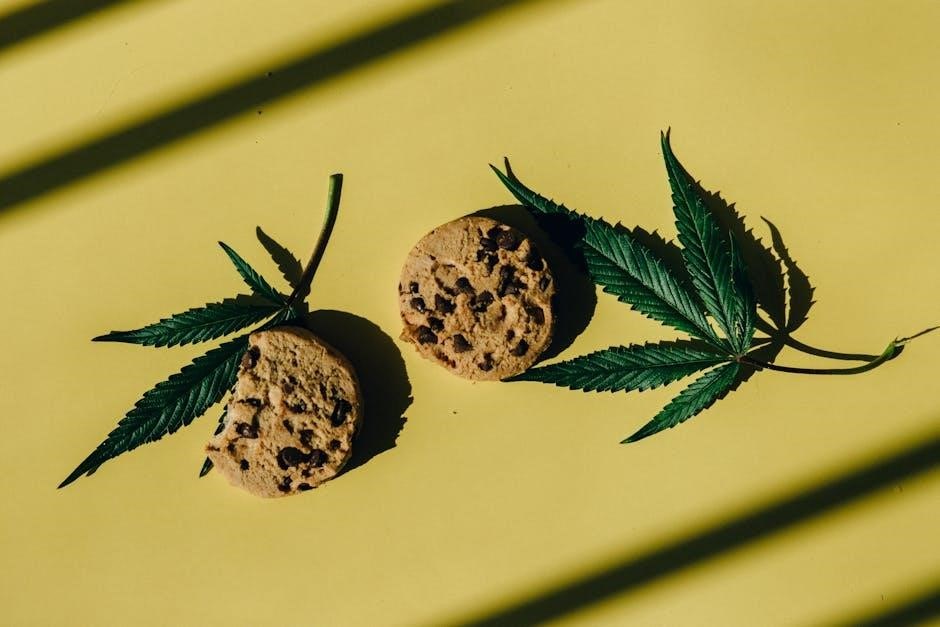
The Process of Making Marijuana Edibles
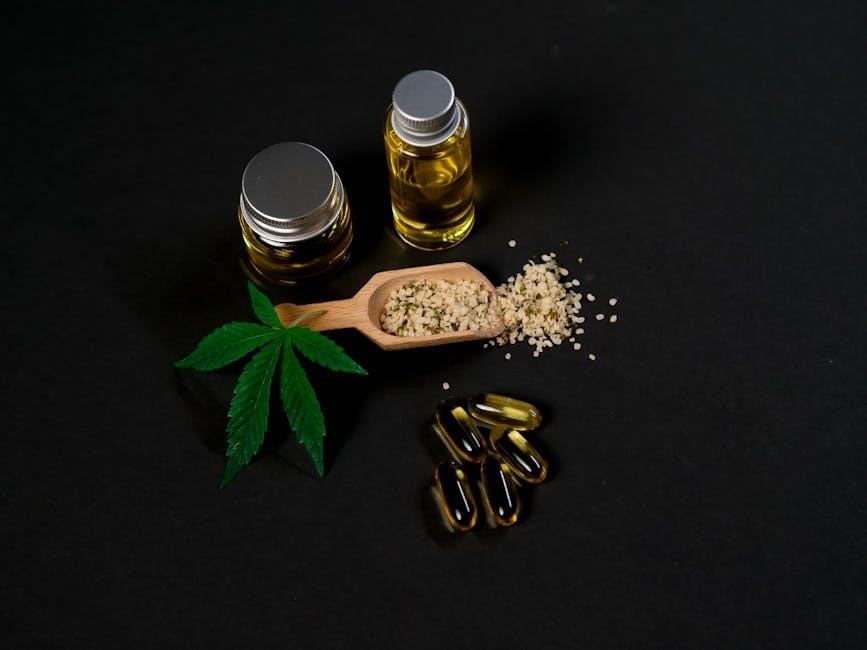
Making edibles involves decarboxylation‚ infusing cannabis into butter or oil‚ and incorporating it into recipes. Precise measurement and tested recipes ensure potency and safety for consistent‚ enjoyable experiences.
The Decarboxylation Process Explained
Decarboxylation is a critical step in making marijuana edibles. It involves heating cannabis to activate THC from its inactive form‚ THCA. This process typically occurs in an oven at 220–245°F (104–118°C) for 45 minutes to an hour. Proper decarboxylation ensures edibles are potent and effective‚ as raw cannabis cannot produce psychoactive effects. The heat converts cannabinoids‚ making them bioavailable for absorption. This step is essential for infused oils‚ butters‚ and other edible recipes. Without decarboxylation‚ the THC remains dormant‚ and the edibles will not deliver the desired effects. It’s important to monitor temperature and time to avoid burning the cannabis‚ which can reduce potency. Once decarboxylated‚ the cannabis is ready to infuse into the base of your choice for edible creation. This foundational step is crucial for achieving consistent and reliable results in homemade edibles.

Infusion Methods for Edibles
Infusion is the process of transferring cannabinoids from cannabis into a base ingredient‚ such as butter‚ oil‚ or alcohol‚ to create marijuana edibles. There are several methods to achieve this‚ each with unique advantages. One common technique is the hot infusion method‚ where decarboxylated cannabis is steeped in a warm liquid‚ such as oil or butter‚ for several hours. This method allows for even distribution of THC and other cannabinoids. Another popular approach is the cold infusion method‚ which involves steeping cannabis in a liquid at room temperature for an extended period‚ often days or weeks‚ without heat. This method is ideal for preserving delicate terpenes and cannabinoids.
Additionally‚ some enthusiasts use alcohol-based tinctures‚ where cannabis is soaked in a high-proof alcohol to extract cannabinoids‚ which can then be added to recipes. More recently‚ water-soluble infusions have gained traction‚ offering easier absorption and versatility in recipes. Regardless of the method‚ proper infusion ensures consistent potency and flavor in edibles. Always use high-quality cannabis and carefully monitor temperature and time for optimal results.
Making Cannabis-Infused Butter (Cannabutter)
Making cannabis-infused butter‚ or cannabutter‚ is a fundamental step in creating marijuana edibles. This versatile ingredient can be used in baking‚ cooking‚ or as a direct consumable. To begin‚ decarboxylate your cannabis by baking it in a preheated oven at 240°F (115°C) for 45 minutes to activate the THC. Next‚ grind the decarboxylated cannabis finely and combine it with melted butter in a saucepan. Simmer the mixture on low heat for 2-3 hours‚ stirring occasionally‚ allowing the cannabinoids to infuse into the butter.

After infusion‚ strain the mixture through a cheesecloth or fine-mesh sieve into a heat-resistant container. Discard the solids and let the butter cool. Once solidified‚ the cannabutter is ready to use. For storage‚ keep it in an airtight container in the refrigerator for up to 6 months. When using cannabutter in recipes‚ ensure accurate dosing by calculating the THC content per serving. Start with small amounts to assess potency and adjust as needed for a safe and enjoyable experience.
Creating Cannabis-Infused Oil
Creating cannabis-infused oil is a popular method for incorporating marijuana into edibles‚ especially for those who prefer a dairy-free or vegan option. To start‚ you’ll need a carrier oil like coconut or olive oil‚ cannabis buds‚ a saucepan‚ cheesecloth‚ and an airtight container for storage. Begin by decarboxylating the cannabis in a preheated oven at 240°F (115°C) for 45 minutes to activate the THC.
Next‚ grind the decarboxylated cannabis and combine it with the oil in a saucepan. Heat the mixture on low heat for 2-3 hours‚ stirring occasionally‚ to allow the cannabinoids to infuse into the oil. Avoid boiling‚ as high heat can degrade the THC. After infusion‚ strain the mixture through cheesecloth into a clean container. Squeeze the cheesecloth gently to extract as much oil as possible‚ then discard the solids.
Store the infused oil in an airtight container in a cool‚ dark place. It can be used in cooking‚ baking‚ or as a finishing oil for dishes. When using cannabis-infused oil‚ start with small doses to assess potency and adjust accordingly for a safe and enjoyable experience.
Comparison of Butter and Oil Infusion
When it comes to infusing cannabis into edibles‚ two popular methods are butter and oil infusion. Each has its unique advantages‚ and the choice depends on the desired outcome and recipe requirements. Cannabutter is ideal for baked goods‚ as butter is a common ingredient in many recipes. It has a rich‚ creamy texture and can enhance the flavor of edibles like brownies or cookies. On the other hand‚ cannabis-infused oil is more versatile and can be used in both sweet and savory dishes‚ making it a great option for sautéing‚ salad dressings‚ or marinades.
In terms of potency‚ both methods can deliver similar THC levels if properly prepared. However‚ butter tends to have a slower onset of effects due to its fatty composition‚ while oil-infused edibles may take effect slightly faster. Shelf life also varies: cannabutter typically lasts longer than infused oil when stored properly. Additionally‚ oil infusion is a better choice for those with dairy restrictions or vegan dietary preferences.
Ultimately‚ the choice between butter and oil comes down to personal preference‚ recipe needs‚ and dietary restrictions. Both methods are effective for creating potent and delicious marijuana edibles.
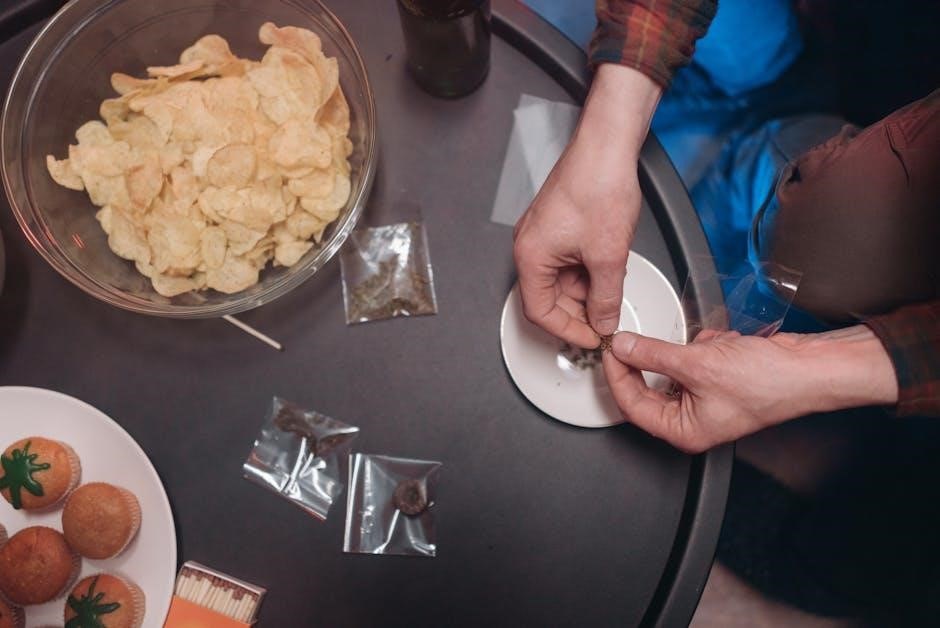
Choosing the Right Cannabis Strain
Selecting the right cannabis strain is crucial for making marijuana edibles‚ as different strains offer unique effects‚ flavors‚ and potencies. The primary factors to consider are THC and CBD levels‚ which determine the intensity and type of experience. High-THC strains are more psychoactive‚ while high-CBD strains provide a milder‚ more therapeutic effect. Additionally‚ the terpene profile of the strain significantly impacts the flavor and aroma of the edibles‚ making it essential for achieving the desired taste.
Sativa strains are often preferred for their uplifting and energizing effects‚ making them ideal for daytime use. Indica strains‚ known for their relaxing and sedative properties‚ are better suited for evening or bedtime edibles. Hybrid strains offer a balanced experience‚ combining the benefits of both sativa and indica. When choosing a strain‚ consider the intended use of the edibles‚ whether for recreation‚ relaxation‚ or medical purposes.
It’s also important to source high-quality cannabis to ensure potency and consistency in your edibles. Always verify the strain’s lab results to confirm THC and CBD content. By selecting the right strain‚ you can tailor your edibles to meet your specific needs and preferences‚ enhancing the overall experience.
Popular Marijuana Edible Recipes
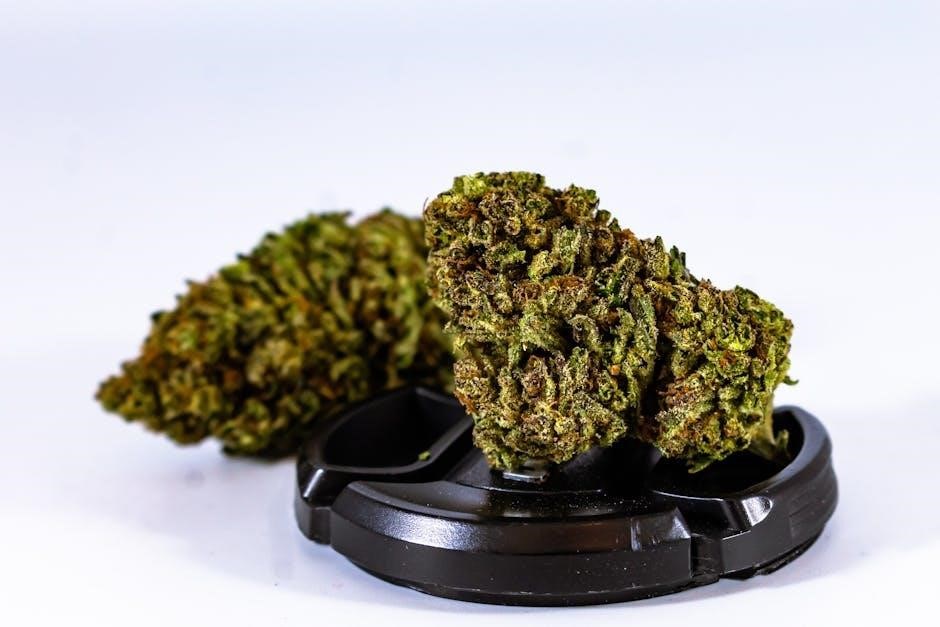
When it comes to making marijuana edibles‚ there are countless delicious and creative options to explore. One of the most popular recipes is cannabis-infused brownies‚ a classic choice that combines rich chocolate with a subtle herbal flavor. Another favorite is cannabis cookies‚ which can be made in various forms like chocolate chip or oatmeal raisin for a personalized touch. For those with a sweet tooth‚ cannabis gummies are a fun and discreet option‚ offering a fruity twist on traditional edibles.
Cannabis granola bars are a great choice for health-conscious individuals‚ providing a nutritious snack with a boost. Cannabis fudge is another indulgent treat that’s easy to make and perfect for portion control. For something savory‚ cannabis pizza can be a unique and satisfying meal. Cannabis trail mix is also a popular choice for its convenience and customizable ingredients. Lastly‚ cannabis-infused honey or maple syrup allows for versatility in sweetening beverages or topping foods. These recipes cater to various tastes and preferences‚ making edibles accessible and enjoyable for everyone.
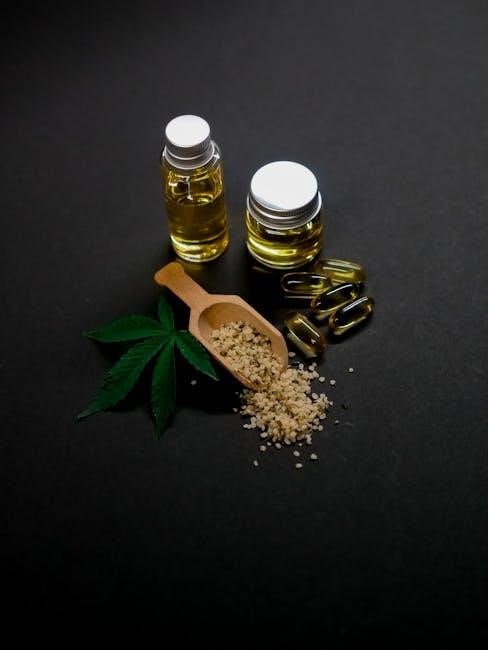
Safety and Consumption Tips
Start with low doses and wait 60-90 minutes for effects. Label edibles clearly and avoid mixing with alcohol or medications; Store securely‚ out of reach of children. Consult a healthcare professional before consumption‚ especially with pre-existing conditions.
Guidelines for Responsible Consumption
Responsible consumption of marijuana edibles is crucial for a safe and enjoyable experience. Always start with a low dose and wait at least 60-90 minutes to assess the effects before consuming more. Ensure you are in a comfortable and familiar environment‚ preferably with a trusted person nearby. Avoid mixing edibles with alcohol or other substances‚ as this can amplify unintended side effects. Stay hydrated to help manage any anxiety or discomfort. Plan your day accordingly‚ as edibles can impair focus and coordination‚ making it unsafe to operate machinery or handle responsibilities. Keep a list of emergency contacts handy and be aware of local laws and regulations. Never share edibles with minors or individuals who are not aware of the contents. By following these guidelines‚ you can minimize risks and maximize the benefits of marijuana edibles.
Potential Risks and Side Effects
While marijuana edibles can offer therapeutic benefits‚ they also carry potential risks and side effects. Common reactions include anxiety‚ paranoia‚ or increased heart rate‚ particularly for first-time users or those who consume too much. Overconsumption can lead to nausea‚ dizziness‚ or disorientation. Some individuals may experience impaired cognitive function‚ affecting concentration and decision-making. It’s important to note that edibles can vary widely in potency‚ and their effects may differ based on individual tolerance and metabolism. In rare cases‚ overconsumption can result in severe reactions‚ such as panic attacks or prolonged disorientation. Always prioritize low doses and gradual consumption to minimize these risks. Additionally‚ edibles can interact with medications or worsen pre-existing conditions like mental health disorders. It’s crucial to consult a healthcare professional before using edibles‚ especially for medical purposes. Proper dosage and awareness of potential side effects are key to a safe and positive experience. If severe symptoms arise‚ seek medical assistance immediately.
Legal Considerations and Regulations
Marijuana edibles are subject to varying legal frameworks depending on the jurisdiction. In regions where cannabis is legalized‚ edibles are often regulated under specific laws governing their production‚ sale‚ and consumption. These regulations may include licensing requirements for manufacturers‚ restrictions on THC content‚ and rules about packaging and labeling. For instance‚ many jurisdictions impose limits on the amount of THC per serving or per product to ensure consumer safety. Additionally‚ age restrictions apply‚ typically prohibiting the sale or consumption of edibles to individuals under 21.
It is crucial to understand that even in areas where cannabis is legal‚ homemade edibles may not be subject to the same testing and safety standards as commercial products. This means individuals must exercise caution when creating edibles to avoid unintentionally violating local laws. Furthermore‚ transporting edibles across state or national borders‚ even into areas where cannabis is legal‚ can lead to serious legal consequences. Always consult local laws and regulations before making or consuming marijuana edibles. Compliance is essential to avoid legal repercussions‚ such as fines or penalties.
Health Impacts of Marijuana Edibles
Marijuana edibles can have both positive and negative health impacts‚ depending on usage and individual tolerance. Edibles are known to provide longer-lasting effects compared to smoking‚ which can be beneficial for managing chronic pain‚ inflammation‚ and anxiety. They also offer a smoke-free alternative‚ reducing respiratory risks associated with inhalation. However‚ the delayed onset of effects can lead to overconsumption‚ resulting in unintended side effects such as increased anxiety‚ paranoia‚ or nausea.
Regular or excessive use of high-THC edibles may contribute to dependence or impaired cognitive function‚ particularly in adolescents and young adults. Edibles with balanced THC and CBD ratios are often preferred for their milder and more therapeutic effects. Proper dosage control is essential to avoid adverse reactions‚ especially for first-time users. Additionally‚ individuals with pre-existing mental health conditions or vulnerable populations‚ such as pregnant women‚ should exercise caution or avoid edibles altogether.
Research suggests that moderate consumption of marijuana edibles can be safe for most adults‚ but it is crucial to prioritize responsible use and consult healthcare professionals for personalized advice. The health impacts vary widely‚ making it important to weigh benefits against potential risks based on individual circumstances.

Usage Trends and Studies
Recent studies and market trends indicate a growing popularity of marijuana edibles‚ particularly among health-conscious consumers seeking alternatives to smoking. The global edible market is projected to expand significantly‚ driven by increasing legalization and the demand for discreet‚ convenient cannabis products. Surveys show that edibles are often preferred for their ability to provide consistent‚ long-lasting effects‚ making them a favorite for both recreational and medical users.
Research highlights that younger demographics‚ particularly millennials and Gen Z‚ are leading the trend‚ with a strong preference for low-dose‚ precisely measured products. This shift reflects a broader movement toward microdosing and wellness-focused cannabis consumption. Additionally‚ studies suggest that edibles are increasingly being used for therapeutic purposes‚ such as managing chronic pain‚ improving sleep‚ and reducing anxiety.
Market data reveals that edible sales have surged in legal markets‚ with gummies‚ chocolates‚ and baked goods being the most popular forms. Innovations in product formulation‚ such as fast-acting edibles and functional ingredients‚ are further boosting demand. These trends underscore the evolving perception of cannabis as a mainstream health and wellness product.
Studies also emphasize the importance of consumer education and regulation to ensure safe and responsible use of edibles. As the market continues to grow‚ ongoing research will play a critical role in shaping the future of cannabis-infused products.
